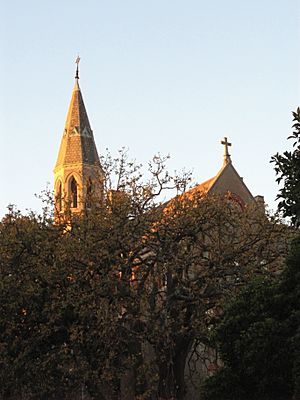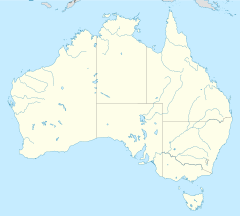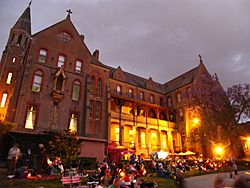Abbotsford Convent facts for kids
Quick facts for kids Abbotsford Convent |
|
|---|---|

Abbotsford Convent
|
|
| Religion | |
| Affiliation | Roman Catholic |
| Location | |
| Location | 1 St Heliers St, Abbotsford, Victoria, VIC 3067 |
| Architecture | |
| Architectural type | Church |
The Abbotsford Convent is a very special place in Abbotsford, Victoria, a suburb of Melbourne, Australia. It sits right by a bend in the Yarra River. Nearby, you'll find the Collingwood Children's Farm.
For over 100 years, this large 6.8-hectare site was one of the biggest convents in Victoria. It was a home for Catholic nuns. During this time, the Abbotsford Convent helped thousands of women and children. It gave them a safe place to live, food, education, and work. Many of these people were experiencing poverty or needed support.
This convent is so important that it was added to the National Heritage List in 2017. This means it has outstanding historical value to Australia.
Today, the Abbotsford Convent is a busy hub for arts, learning, and culture. Its old buildings and beautiful gardens are home to many creative people and groups. You can find a classical music radio station (3MBS), a Steiner School (Sophia Mundi), live music, art galleries, and even markets here. There's also a bakery, cafe, and a restaurant.
There are 11 main buildings on the site. These include the Convent, St Euphrasia, Providence, Rosina, St Mary's, Mercator, Magdalen Laundries, Sacred Heart, Industrial School, and St Anne's.
Contents
History of the Convent
Early Days of the Land
For thousands of years, the land around the convent was enjoyed by the Wurundjeri people. They are the traditional owners of this land. The nearby meeting point of the Yarra River and Merri Creek was very important to them.
In 1803, Charles Grimes explored the Yarra River by boat. This part of the river valley has changed very little since then. It's one of the most untouched areas from early European contact in Victoria.
People have been farming on this land since 1838. This makes the Abbotsford area one of the oldest continually farmed places in Victoria. It's also unique because it's the only example of a working inner-city convent farm in a major city anywhere in the world. The Collingwood Children's Farm, which started in 1979, continues this farming tradition today.
The Sisters of the Good Shepherd
From 1863 to 1975, the Sisters of the Good Shepherd lived and worked at the convent. They were an order of the Roman Catholic church. For over a century, these Sisters provided a home, schooling, and work for girls and women. Many were orphans or young people who needed help and guidance.
The convent was largely self-sufficient. It had vegetable gardens, fruit trees, and farms for dairy, poultry, and pigs. They also earned money by making lace and offering laundry services. At its busiest, the Convent could house up to 1,000 people.
The Abbotsford area was an important industrial region in Melbourne. Many working-class families lived there, and the convent was a significant landmark for the community.
Today, the former Convent of the Good Shepherd is known as the most important Catholic institution built in Victoria. Since the early 2000s, it has become a lively community hub for arts and culture.
Buildings and Architecture
The former Convent of the Good Shepherd is famous for its large size and the beautiful design of its buildings. It has a medieval French church-like style. Important parts include the Industrial School and the Magdalen Asylum. The main convent building and its gardens are grand and impressive. Many of these old features are still here today.
- Industrial School: This building was part of the convent's work to teach skills.
- Kitchen Annex (1902): This kitchen was built to prepare food for up to 1,000 people. It was the largest kitchen in Victoria in 1902.
- Magdalen Laundries: These buildings were used for commercial laundry services.
- Mercator (1880s-1960s): This building was built in stages and first used for laundry.
- Today, it's a facility for the Sophia Mundi Steiner School.
- Providence (1887): This building was once a finishing school and dormitories.
- Now, it houses the Convent Foundation's office and the Wurundjeri Tribe Land Council.
- Rosina (1908): This building used to be dormitories and dining areas.
- Currently, it's used for performances and events.
- Sacred Heart (1877): This building was also dormitories and dining areas. It is not currently in use.
- St. Anne's: Another building on the site.
- St. Euphrasia (1879): This building was first used as a school.
- It is now home to the classical community radio station, 3MBS.
- St Mary's (1911): This building was once a boarding house.
- It now houses the Sophia Mundi Steiner School.
- The Convent (1900–1903): This main building held the Sisters' rooms, meeting areas, dining hall, and library.
- Today, it has offices, artist studios, meeting rooms, and food shops.
Events and Activities
The Abbotsford Convent is a busy place with many fun events throughout the year.
Music Events
- Shadow Electric Band Room: Regular live music shows happen here.
- Beg, Scream & Shout: A music event.
- Push Over: An all-ages music event (held in March 2010).
- Lentil as Anything: Often has spontaneous musical performances.
- Carols at The Convent: Christmas carol events (held from 2005–2008).
Markets to Explore
- Supper Market: Held every Friday evening in Summer.
- Shirt & Skirt Market: Happens on the third Sunday of every month.
- Makers' Market: Also on the third Sunday of every month.
- Slow Food Farmers' Market: Held on the fourth Saturday of every month.
Festivals and Fairs
- Found Festival (May 2014)
- Persian Fair
- Fringe Furniture
- Globelight
- One Fine Day Wedding Fair
- Writers at the Convent: A literary festival (in February).
- Crime & Justice: Another literary festival (in July).
- Open Source Developers' Conference Australia, 2010
Film Screenings
- The Shadow Electric Open Air Cinema: An outdoor cinema open during Summer.




